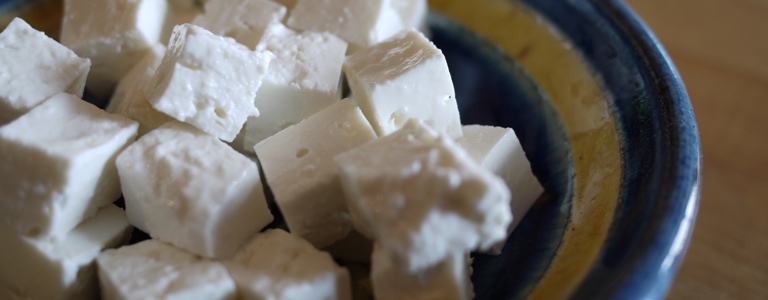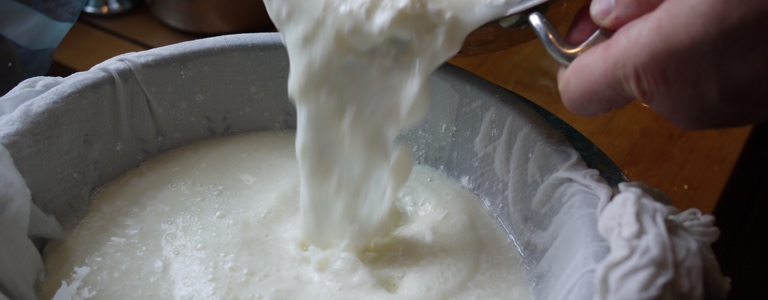Feta Cheese, Greece
For thousands of years, people in the eastern Mediterranean region have produced a white cheese made from a mixture of goat and sheep milk and stored in brine (London School of Economics (LSE), 2007). While it is unclear as to exactly when this cheese first appeared, some scholars believe that it could date back as far back as 8,000 years (Mike Peluso, Cornell University, 2005). One of the most famous variants is perhaps Feta cheese from Greece (World Intellectual Property Organization (WIPO), 2008).

While Greece is the world’s largest consumer of Feta cheese (LSE, 2007) and accounts for over 85 percent of all annual consumption in the European Union (EU) (Hogan & Hartson LLP, 2005), most production is for the domestic market (USA Today, 2005), with the country accounting for less than 30 percent of global Feta cheese exports (McKinsey & Company, 2012). Greece has enjoyed an increase in Feta cheese product exports since 2011 (Ekathimerini, 2016), however for decades other European countries significantly surpassed Greece in exports of this commodity (New York Times, 2012). For many consumers the word “Feta” is therefore a generic name for different types of white, crumbly cheese stored in brine (LSE, 2007).
In the 1930s Greece laid out rules of production for Feta cheese (Wisconsin Center for Dairy Research, 2003) to ensure it would be produced in accordance with long-standing traditional techniques. This was expanded to protect the geographical location of production and officially enacted into Greek law in 1988 (European Commission (EC), 2002).
With the introduction of Protected Designations of Origin (PDOs) in the EU in 1992 and increased concern over products being marketed as Feta cheese with different ingredients, production methods, and a perceptibly dissimilar taste (LSE, 2007), in 1994 Greece sought to register Feta cheese as a PDO in the EU (EC, 2002). This application was the start of long process that proved while obtaining a geographical indication (GI, such as a PDO) is not always an easy or quickly successful process (WIPO, 2008), it can be worth it in the long run.
Goods with specific geographical origin
According to Article 1 of Ministerial Order 313025/1994 in Greece, milk used for the production of feta cheese must come exclusively from sheep and goats in the Greek regions of West Macedonia, Central Macedonia, East Macedonia, Thrace, Epirus, Thessaly, Central Greece, Peloponnese, and the department of Lesbos, which is an island in the northeastern Aegean Sea (EC, 2005).
This is due to the climate in these regions and its influence on Feta cheese production. Greece has a varied climate, from sun-drenched islands to snow capped peaks (Water Resources Development, 2008), and an equally diverse flora comprising of over 6,000 species (EC, 1994). At the same time, much of the country has rather harsh conditions. This is particularly true in Feta producing regions, with over two-thirds of the terrain being mountainous, exposed to hot and dry temperatures, abundant sunshine, and quantifiably few overall food sources (EC, 1994). Sheep and goats in these regions have therefore become hardy, resilient, and adapted to local climates (EC, 1994).
To ensure that their herds have access to enough food, farmers in these areas allow their animals to graze over extensive areas of land with a diverse range of flora (according to a 2011 presentation by Sofia Manana of the Hellenic Ministry of Rural Development and Food and provided to the WIPO Japan Office (WJO) courtesy of the Embassy of Greece in Tokyo (EGT)). The interplay between the climate and flora has resulted in goat and sheep milk from these regions to develop rich chemical composition and organoleptic properties (EC, 1994). Combined with traditional production methods, Greek Feta cheese has developed its unique aroma, flavor, consistency, and characteristics (New York Times, 2006).

Traditional knowledge
Farmers in Feta producing regions of Greece have intimate knowledge of the climate, their herds, and how they relate. Using this knowledge, a common production process emerged that was enumerated in national regulations that formed the basis for the Feta cheese PDO (EC, 1994).
Features of this process include a seasonal dairy production of 6 to 8 months out of the year; milk collection once per day in cold temperatures and twice per day in warm temperatures; a fat content of between 6 and 8 percent; treating it with heat (pasteurized) or without (unpasteurized); abstaining from using colorants, preservatives, or condensed or powdered milk; using rennin (natural enzymes) to coagulate the milk; straining milk curd without pressure; salting it with coarse grained salt; and ripening it in brine for at least 15 days (EC, 1994). Greek Feta cheese must contain a minimum of 70 percent sheep’s milk and no more than 30 percent goat’s milk (Government of Greece, 2013).
Although modern processes have been implemented to a certain degree in some areas of production (such as the automated cutting and salting), according to the Greek government’s rules of production, which are also included in the EU PDO (EC, 2005), the aforementioned traditional techniques must always be respected (EC, 1994). Doing so ensures that Greek Feta cheese retains properties (such as taste and aroma) that make it distinguishable from other products bearing the Feta name (EC, 1994).
Geographical indications and appellations of origin
Since the 1930s Greece was increasingly codifying the production practices for Feta cheese (EC, 2002). Rules for the source of the milk and the production techniques of Feta cheese production first entered into force in the country in 1988 (EC, 2002), and with the 1992 regulation establishing a system for protecting GIs and other agricultural products in the EU (Hogan & Hartson LLP, 2005), Greece soon sought to register the Feta name in the EU. In 1994 Greece made an application to the EC for the registration of Feta as a PDO, which was successful in 1996. However, due to objections from other EU countries this was short lived. The Feta PDO was annulled in 1999, and following a long series of IP disputes its registration would not officially be confirmed until 2005 (EC, 2005).
IP dispute resolution
Under Greece’s 1988 legislation the composition and production techniques of Feta are protected (EC, 2002). Domestic producers were largely unaffected, but importers faced new challenges to marketing cheese in Greece using the Feta name. For example, in 1991 Greek authorities seized a shipment of Danish Feta cheese on the grounds that it violated this legislation, which represented the start of a series of IP disputes over the use of the Feta name (European Communities Trademark Association (ECTA), 2006).
With the 1996 PDO registration, other Feta producing countries in the EU viewed the Greek PDO as a threat to their Feta exports. Indeed, while over 85 percent of Feta cheese consumption in the EU is in Greece, the country owns less than 30 percent of the export market. Denmark, France, Germany, and the UK command most of the export market in the EU, with minimal domestic consumption (EC, 2002). These countries brought the issue to the European Court of Justice (ECJ) in 1999 (EC, 2005). Their main argument was that Feta was a generic term that relates to the place it was originally marketed or produced but has become the common name of that product or food (Hogan & Hartson LLP, 2005). Siding with the plaintiffs, the ECJ deleted the Feta PDO from the EU register (ECTA, 2006).
Following this ruling the ECJ sent a questionnaire to all EU member states to determine the actual situation of the production and consumption of Feta cheese and knowledge of the term among consumers in these countries (EC, 2005). The results were sent to a Scientific Committee who unanimously concluded that Feta was not generic (LSE, 2007) and reinstated the PDO in 2002. Denmark, France, Germany, and the UK disputed this finding, arguing again that Feta has been used as a generic term in many EU countries since the 1930s (ECTA, 2006) and that there is no geographical reason that makes Greek Feta cheese more unique than Feta cheese produced in other countries (ECTA, 2006).

However, the ECJ found that most consumers in these other EU member states did not actually consume a significant amount of Feta cheese (EC, 2005). Furthermore, nearly all of the packaging for Feta cheese exports from these countries has some type of reference to Greek culture (LSE, 2007). This, the ECJ ruled, would cause consumers to immediately associate Feta cheese as a Greek product (EC, 2005). Lastly, Feta cheese that is produced in other countries is by and large made with cow’s milk, which is not the case for Greek feta cheese (Government of Greece, 2013). In 2005 the ECJ ruled that Feta cheese was not generic and the PDO registration was confirmed (EC, 2005). Other countries in the EU marketing products with the Feta name had a three-year grace period to change or re-label their product names (LSE, 2007).
Even with the PDO secured, Feta cheese producers in Greece continue to face challenges due to a limited number of companies in other countries. “In most cases these companies have manufacturing facilities outside of the EU,” the EGT explained in an email interview with the WJO, and that “…in countries where the origin of the product does not have to be mentioned on the label, it is difficult to know where the products originate from.”
According to the EGT, unless a treaty is in effect between these countries and the EU, regulations governing PDO products such as Feta cheese do not apply. This can prove problematic as smallholder producers in Greece could find themselves competing with larger companies outside the EU who are marketing products with the Feta cheese name despite having a different origin. As the EGT said, “…there are no legal means we can use in order to stop a non-EU company from producing and selling ‘Feta cheese’ or other PDO products.”
To counter this effect, the EU is actively seeking the inclusion of provisions that protect EU PDOs in various treaties, and by early 2015 was successful in countries such as Canada and South Korea (Financial Post, 2014).
Commercialization
Whether it is made for sale at a large industrial dairies or cottage industries, Greek and EU legislation require Feta cheese to be produced using traditional techniques and sheep and goat milk from specific regions (Government of Greece, 2013). It is sold in individual packaged pieces, by bulk from larger dairies, or for sale by the slice in establishments such as local delis or small cheese shops. Producers must have licenses from the Hellenic Ministry of Rural Development and Food to commercialize Feta cheese, which is to ensure that all Feta products meet the same level of quality (Mike Peluso, Cornell University, 2005).
Greece produces approximately 115,000 metric tons of Feta cheese annually (EC, 2005), mostly for domestic use. While the country owns a small share of the worldwide export market (McKinsey & Company, 2012), demand has been rising (The Council of Canadians, 2013). With the Feta cheese PDO registration confirmed, some analysts argue that the time is ripe for Greece to expand on its global commercialization efforts (McKinsey & Company, 2012).

Business results
Even in difficult economic times Feta cheese has been one of Greece’s highlights, with the industry enjoying growth and increased exports (McKinsey & Company, 2012). This has provided jobs for thousands of people, including those in some of the country’s poorest regions where approximately 75 percent of Feta cheese is produced (Government of Greece, 2013).
The EGT highlighted this success in an interview via email with the WJO, noting that in 2013 the value of exports of Greek cheeses was approximately 287 million Euros, representing a 73 percent increase compared to 2004. Feta cheese, the Embassy explained, represents approximately 86 percent of these exports. By 2012 Greek Feta cheese was exported to over 35 countries on 5 continents (Export Gate, 2012).
A non-generic history
Feta cheese has spread to nearly every major market in the world and enjoys a long history and internationally recognizable name (Mike Peluso, Cornell University, 2005). While there are many similar cheeses made in other countries, the PDO registration in the EU has confirmed to many that the Feta name is not a generic term. Although controversy over the Feta name continues, the Feta PDO registration helps protect producers and allows them to compete internationally, all while providing a product of credible origin that is desired in many parts of the world.
Source: WIPO

 Client Focus
Client Focus